
 Monday Glamour Starter --- Mae West --- Part One
Monday Glamour Starter --- Mae West --- Part OneModern viewers are generally uneasy with Mae West. She’s harder to warm up to with each passing generation. There’s an unearthly quality about her appearance and personality that belongs to an era and mindset our culture will never again embrace. Mae’s battle was won well before she died, the prudes and would-be censors having decades since been routed. Accounts of her bold strokes against long-ago propriety and convention must be accepted on faith, for there’s nothing in her movies to suggest this woman was the twentieth century’s defining threat to public morality. Kids looking upon that overripe figure today would no doubt dismiss Mae West as yet another instance of their ancestor’s peculiar taste in entertainers. As long as there were standards for Mae West to outrage, she’d keep her following, but how could she have anticipated living enough years to see all those standards so blithely swept aside? Mae spent her career advocating a wide-open world, but this was really the last thing she needed or even wanted. She got it, though, even if it came at the ultimate cost of her own relevance.

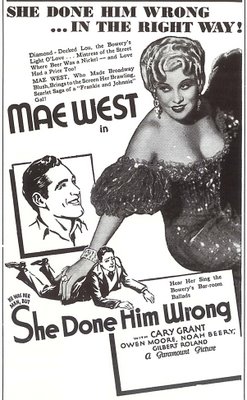
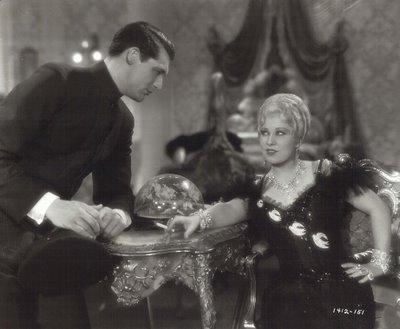 Mae was born during those Gay Nineties she’d forever hark back to in stage and films. Worth noting is the fact that her Brooklyn address was within two blocks of Clara Bow’s eventual birthplace (they were twelve years apart). Mae’s roustabout father made carriages, among other trades less savory, and the family lived tolerably well. I have this mental image of trotting horses carrying an adolescent Mae by the miserable coldwater flat the Bows occupied, and perhaps she and little Clara exchanging a glance. Might have happened. Anyway, Battling Jack, as the father was known (and not necessarily with affection) wasn’t above taking Mae to any number of low dives where he kept company with boxers, petty criminals, and other brawn over brain types. This is where she nurtured the taste in men that would stay with her a lifetime. As a child, Mae often dreamed of sex with a grizzly bear (no, I’m not drinking, nor is this a typo). She found such eventful sleep relaxing. A possibly unhealthy relationship with Battling Jack might have had something to do with this, though she also developed a yen for lions and their tamers. The only person Mae really cared about was her mother, and their mutual devotion excluded all rivals, particularly a sad-sack sister who was every kind of undisciplined screw-up Mae wasn’t, and both mother and favored daughter let her know all about it. A real Blanche and Jane Hudson thing was taking root, and it would last their lifetimes.
Mae was born during those Gay Nineties she’d forever hark back to in stage and films. Worth noting is the fact that her Brooklyn address was within two blocks of Clara Bow’s eventual birthplace (they were twelve years apart). Mae’s roustabout father made carriages, among other trades less savory, and the family lived tolerably well. I have this mental image of trotting horses carrying an adolescent Mae by the miserable coldwater flat the Bows occupied, and perhaps she and little Clara exchanging a glance. Might have happened. Anyway, Battling Jack, as the father was known (and not necessarily with affection) wasn’t above taking Mae to any number of low dives where he kept company with boxers, petty criminals, and other brawn over brain types. This is where she nurtured the taste in men that would stay with her a lifetime. As a child, Mae often dreamed of sex with a grizzly bear (no, I’m not drinking, nor is this a typo). She found such eventful sleep relaxing. A possibly unhealthy relationship with Battling Jack might have had something to do with this, though she also developed a yen for lions and their tamers. The only person Mae really cared about was her mother, and their mutual devotion excluded all rivals, particularly a sad-sack sister who was every kind of undisciplined screw-up Mae wasn’t, and both mother and favored daughter let her know all about it. A real Blanche and Jane Hudson thing was taking root, and it would last their lifetimes.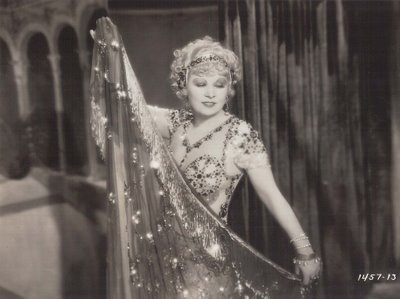
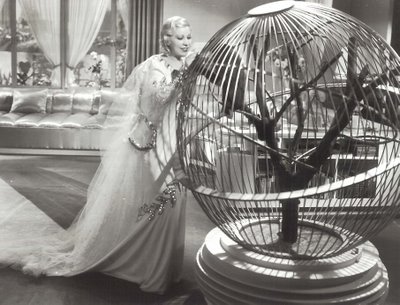
Vaudeville was the same broken glass route for Mae as it would be for any aspirant in those early century days --- the climb up yielded thin air for those made of softer tissue. Mae’s was a leathery resolve, however, and she learned the hard way what worked best for her. Once that formula was laid, no one else would ever be permitted to write her stuff. She’d forever remain a one-woman show. The sex angle was an audience preference she detected early on, but no artist had Mae’s daring for dishing the dirt in otherwise staid theatrical environments. She took the bawdy out of burlesque and put it on Broadway. The plays she wrote celebrated the lowlife element encountered during childhood. They weren’t Ibsen, but SEX, Drag, The Wicked Age, and Diamond Lil gave audiences and readers a slumming tour through back-alleys they’d never venture near in person, and Mae’s own carnal exploits seemed to multiply with each interview she gave. Thumbing one’s nose at propriety in those days carried a stiff price, as Mae discovered when she and her stage company were hauled into court and tried for indecency. She actually pulled a little slam time, but that was nothing but a good thing for a sexual revolutionist like Mae. Gangland links provided funds for expensive mounting her shows required. Owney Madden was a close friend and silent partner. Trusted lieutenant George Raft, his own movie stardom still a few years in the offing, came down each night to check receipts on Owney’s behalf.
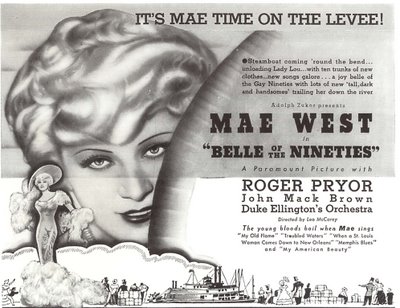
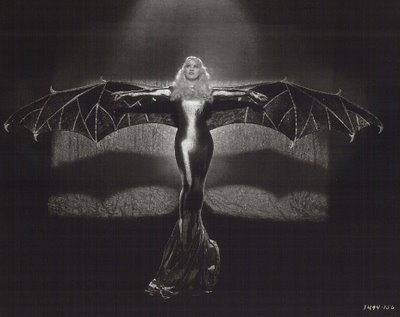
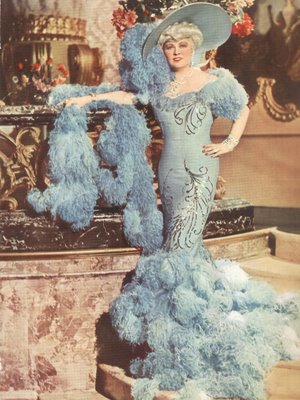
Not all her plays were hits, but Mae was. She was a natural for talking pictures. The first of these was Night After Night, which was ironically a George Raft vehicle, his train having reached Hollywood a year or so in advance of Mae’s. Suffice to say she stole everything but the camera (Raft’s tribute), so a starring role was solidly in the bag. That was She Done Him Wrong, and from here on, all Mae’s directors felt themselves done very wrong by this determined and uncompromising woman. The fact is, she just happened to know her business better than they thought they did. Paramount was busy counting the fantastic rentals her pictures were getting, so no argument there. Mae developed a way of taking credit for things she did and others she didn’t. Her movie act was more or less a refinement of what Texas Guinan used to give patrons in her legendary NYC nightclub, but potential litigation showdown was averted by Guinan’s premature death --- Mae was like a sponge when it came to overheard wisecracks and repartee. Funny things she heard had a way of showing up in her own routines sooner or later. She’d even incorporate Cary Grant’s stardom into her personal inventory of life achievements. Subsequent interviews found Mae discovering Grant among a herd of nameless extras and bestowing the career defining break of co-starring with her. As Cary himself would later say, she never told the truth in her life, and while that may be a tiny bit severe, Mae herself might have acknowledged a fondness for occasional embroidery, especially when it fostered a good story. A more damning, and poignant, Grant observation pointed out Mae’s construction of her stage personality as having blurred her ability to separate fact from fantasy --- but wasn’t this the fate of most stars in their twilight years?
Photo Captions
She Done Him Wrong
With George Raft in Night After Night
Ad Art for She Done Him Wrong
Portrait --- She Done Him Wrong
With Cary Grant in She Done Him Wrong
I'm No Angel
With one of her real-life pet monkeys in I'm No Angel
Ad Art for Belle Of The Nineties
Art Still from Belle Of The Nineties
Color Portrait from a Paramount Exhibitor's Manual
